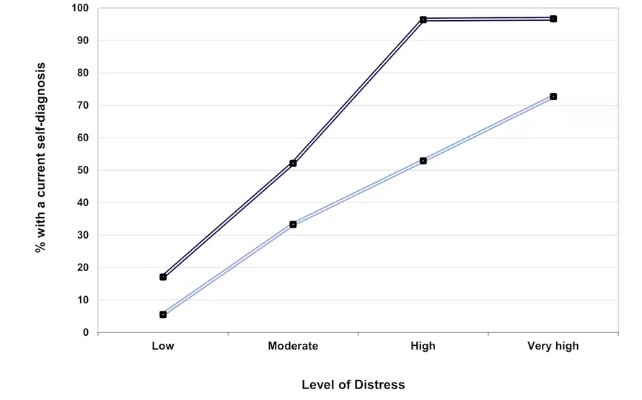Mental illnesses such as depression and anxiety disorders have become more prevalent, especially among young people. Demand for treatment is surging and prescriptions for some psychiatric medications have climbed.
These upswinging prevalence trends are paralleled by rising public attention to mental illness. Mental health messages saturate traditional and social media. Organisations and governments are developing awareness, prevention and treatment initiatives with growing urgency.
The mounting cultural focus on mental health has obvious benefits. It increases awareness, reduces stigma and promotes help-seeking.
However, it may also have costs. Critics worry social media sites are incubating mental illness and that ordinary unhappiness is being pathologised by the overuse of diagnostic concepts and “therapy speak“.
British psychologist Lucy Foulkes argues the trends for rising attention and prevalence are linked.
Her “prevalence inflation hypothesis” proposes that increasing awareness of mental illness may lead some people to diagnose themselves inaccurately when they are experiencing relatively mild or transient problems.
Foulkes’ hypothesis implies that some people develop overly broad concepts of mental illness. Our research supports this view. In a new study, we show that concepts of mental illness have broadened in recent years – a phenomenon we call “concept creep” – and that people differ in the breadth of their concepts of mental illness.
Why do people self-diagnose mental illnesses?
In our new study, we examined whether people with broad concepts of mental illness are, in fact, more likely to self-diagnose.
We defined self-diagnosis as a person’s belief they have an illness, whether or not they have received the diagnosis from a professional. We assessed people as having a “broad concept of mental illness” if they judged a wide variety of experiences and behaviours to be disorders, including relatively mild conditions.
We asked a nationally representative sample of 474 American adults if they believed they had a mental disorder and if they had received a diagnosis from a health professional. We also asked about other possible contributing factors and demographics.
Mental illness was common in our sample: 42% reported they had a current self-diagnosed condition, a majority of whom had received it from a health professional.
(Mental Health America/Pexels)
Unsurprisingly, the strongest predictor of reporting a diagnosis was experiencing relatively severe distress.
The second most important factor after distress was having a broad concept of mental illness. When their levels of distress were the same, people with broad concepts were substantially more likely to report a current diagnosis.
The graph below illustrates this effect. It divides the sample by levels of distress and shows the proportion of people at each level who report a current diagnosis.

People with broad concepts of mental illness (the highest quarter of the sample) are represented by the dark blue line. People with narrow concepts of mental illness (the lowest quarter of the sample) are represented by the light blue line.People with broad concepts were much more likely to report having a mental illness, especially when their distress was relatively high.
People with greater mental health literacy and less stigmatising attitudes were also more likely to report a diagnosis.
Two interesting further findings emerged from our study. People who self-diagnosed but had not received a professional diagnosis tended to have broader illness concepts than those who had.
In addition, younger and politically progressive people were more likely to report a diagnosis, consistent with some previous research, and held broader concepts of mental illness. Their tendency to hold these more expansive concepts partially explained their higher rates of diagnosis.
Why does it matter?
Our findings support the idea that expansive concepts of mental illness promote self-diagnosis and may thereby increase the apparent prevalence of mental ill health. People who have a lower threshold for defining distress as a disorder are more likely to identify themselves as having a mental illness.
Our findings do not directly show that people with broad concepts over-diagnose or those with narrow concepts under-diagnose. Nor do they prove that having broad concepts causes self-diagnosis or results in actual increases in mental illness. Nevertheless, the findings raise important concerns.
First, they suggest that rising mental health awareness may come at a cost. In addition to boosting mental health literacy it may increase the likelihood of people incorrectly identifying their problems as pathologies.
Inappropriate self-diagnosis can have adverse effects. Diagnostic labels may become identity-defining and self-limiting, as people come to believe their problems are enduring, hard-to-control aspects of who they are.

Second, unwarranted self-diagnosis may lead people experiencing relatively mild levels of distress to seek help that is unnecessary, inappropriate and ineffective. Recent Australian research found people with relatively mild distress who received psychotherapy worsened more often than they improved.
Third, these effects may be particularly problematic for young people. They are most liable to hold broad concepts of mental illness, in part due to social media consumption, and they experience mental ill health at relatively high and rising rates.
Whether expansive concepts of illness play a role in the youth mental health crisis remains to be seen.
Ongoing cultural shifts are fostering increasingly expansive definitions of mental illness. These shifts are likely to have mixed blessings. By normalising mental illness they may help to remove its stigma. However, by pathologising some forms of everyday distress, they may have an unintended downside.
As we wrestle with the mental health crisis, it is crucial we find ways to increase awareness of mental ill health without inadvertently inflating it.![]()
Jesse Tse, PhD Candidate at Melbourne School of Psychological Sciences, The University of Melbourne and Nick Haslam, Professor of Psychology, The University of Melbourne
This article is republished from The Conversation under a Creative Commons license. Read the original article.




















Discussion about this post